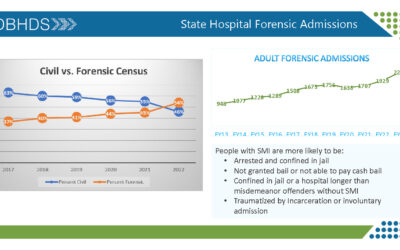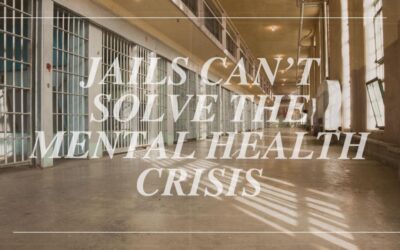NYAPRS Note: Again, advocate Leah Harris lays out an eloquent and powerful agenda for recovery-based mental health reform that displaces the narrative that institutionalization may improve opportunities and health for people with a diagnosis, or could improve overall social conditions and well-being.
In the January issue of the Journal of the American Medical Association (JAMA) University of Pennsylvania bioethicists argued that “prisons have become the nation’s largest mental health care facilities” — replacing the old asylums of the past, phased out since the ’60s in the process known as “deinstitutionalization.” The authors’ controversial commentary recommends a “return to the asylum,” rebuilding large psychiatric facilities.
While the bioethicists rightly point out our collective obligation to address the tragic mass imprisonment of people with mental illness, they largely fail to acknowledge that homelessness is a key component of the crisis they describe. While serious mental health conditions are highly prevalent among the incarcerated population, as the JAMA authors note, this can also be said of the population of homeless people. From a public health perspective, homelessness and incarceration are said to be “mutual risk factors” for one another.
While there isn’t much hard data, experts assert that people who are homeless and have a serious mental illness are at extremely high risk of encounters with law enforcement. About 25-50% of the homeless population has a history of incarceration. Police encounters may lead to imprisonment, largely for nonviolent offenses related to their disability or to addictions. Or they may lead to tragic outcomes associated with the use of deadly force by law enforcement, such as recent high profile shootings of homeless individuals with mental health conditions.
To address the interconnected cycle of homelessness and incarceration, what is needed is not more investment in “asylums” but in supportive housing. A 2012 report on a pilot program in Ohio showed that placing returning prisoners in such programs reduced both re-arrest and incarceration, and increased their likelihood of accessing needed treatment and services.
The JAMA authors’ call to rebuild costly “asylums” reflects our nation’s misguided spending priorities. The United States ranks first in health care spending but 25th in spending on social services among nations in the Organization for Economic Cooperation and Development. This reflects a bad set of decisions with equally poor results. Despite our high health-care spending, we have dismal health outcomes compared with similarly wealthy nations.
Instead, we should be funding community-based services that support recovery and rehabilitation. Research shows that spending on the “social determinants” of health such as permanent, affordable housing and vocational and educational services have far more impact on overall health than medical services alone.
When we fail to invest “upstream” in the social determinants of health, including supportive housing, we pay for it later: in “downstream” spending on mass incarceration, as well as in high-cost increased emergency and inpatient medical care.
Data show that people who are homeless face mortality rates three times higher than the general population and are often “super-utilizers” of emergency services. They are 10 times more likely to be hospitalized than people who are not homeless, and face longer inpatient stays. Supportive housing results in an average hospital cost savings of $3,022 per person per month, or 86% reduction in costs.
“Placing people who are homeless in supportive housing — affordable housing paired with supportive services such as on-site case management and referrals to community-based services — can lead to improved health, reduced hospital use, and decreased health care costs,” Dr. Nirav Shah, former New York State health commissioner, wrote in the New England Journal of Medicine.
Increasing federal, state, and local funding for Housing First programs is clearly the right policy direction. Housing First is an innovative supportive housing model that departs from traditional modes of thinking — namely, that people needed to be clean, sober and free of psychiatric symptoms before they could access housing. This approach resulted in homeless people with serious mental health conditions having to jump through a plethora of formidable barriers to get housing. The Housing First model removes all of these barriers, and this strategy has resulted in remarkable outcomes. Over the last 10 years, using this approach, Utah has been able to reduce homelessness by 75%.
Housing First programs exist in Philadelphia. Pathways to Housing PA and Horizon House are the city’s current providers. Chris Simiriglia, executive director of Pathways to Housing PA, says that Housing First is a critical element in addressing both homelessness and incarceration of those living with mental illness.
Simiriglia feels that what is needed in Philadelphia is to better integrate existing jail diversion programs with Housing First programs. “Currently the system is fragmented,” she said. “We can only serve returning prisoners if they are on the streets long enough to be considered ‘chronically homeless’ and if they are sick enough to be considered to be ‘seriously mentally ill.'” She added, “there are a whole lot of people going in and out of prison who are committing low-level crimes. It is costing the city a fortune to keep them stuck in this cycle.”
While current jail diversion programs in Philadelphia generally connect people with transitional housing, Simiriglia notes that “people do better with permanent, supportive housing.”
The University of Pennsylvania biothecists who recommended a return to asylums were correct in their diagnosis: The status quo is unacceptable, and unjust incarceration of people with psychiatric disabilities must end. But their prescription was wrong. It’s not more asylums we need, but more housing.
Leah Harris is director of the National Coalition for Mental Health Recovery, and coordinator for the Recovery Now! campaign, which seeks to raise awareness of the need for community-based services that facilitate recovery for all Americans affected by mental health conditions.
Reprinted from Philly.com



